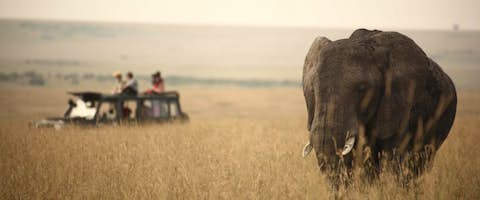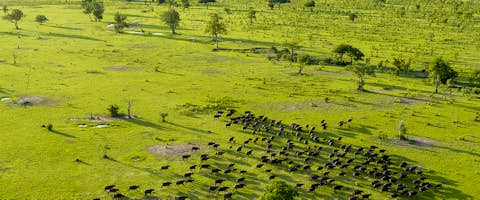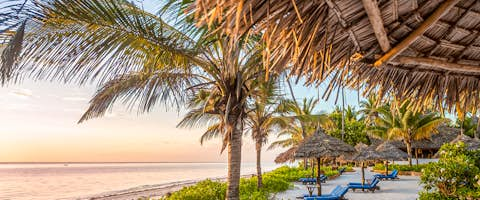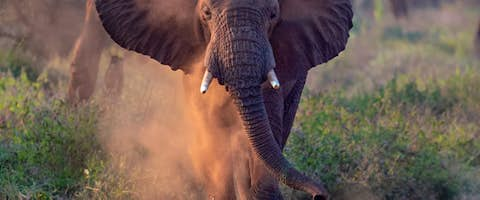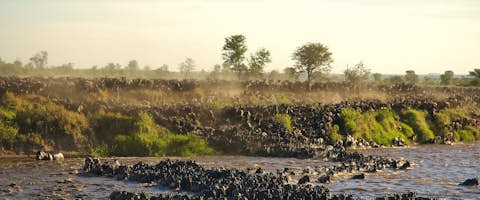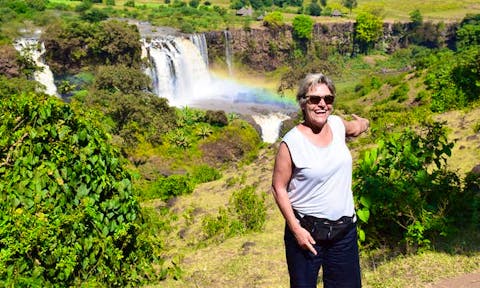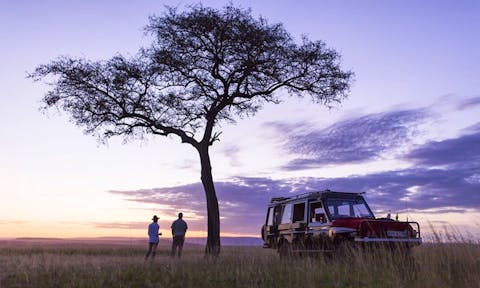Lake Natron, at a glance
Located in northern Tanzania, near the border with neighbouring Kenya, Lake Natron is situated north east of the Ngorongoro Crater. The landscape is dominated by Ol Doinyo Lengai, an active volcano which is just south of Lake Natron.
The lake has a maximum length of 56km and a width of 22km. Lake Natron is primarily fed by the Southern Ewaso Ng'iro River, and by hot springs that are rich in minerals.
As water cannot flow out of the lake, evaporation levels are very high, and this leaves behind natron (sodium carbonate decahydrate) and trona (sodium sesquicarbonate dihydrate).
The high concentration of natron gives the lake extreme alkaline levels, and it is one of the deadliest lakes on the planet. The surrounding landscape is eerie due to its proximity to a deadly body of water, but it is rich with rare flora and fauna.
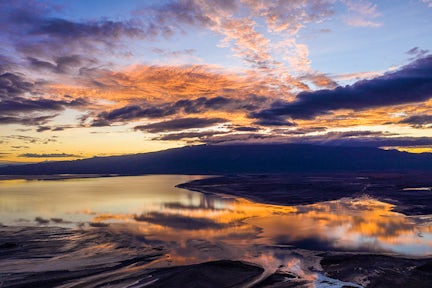
A Perfect Planet
In January 2021, Lake Natron featured in the opening episode of ‘A Perfect Planet’, a BBC series which is narrated by David Attenborough.
Matt Aeberhard, a camera operator during the filming of the episode, explained that ‘the pH level of the lake is not far short of household bleach’. Aeberhard also noted that ‘until recently, more people had landed on the moon than had actually stood out in Lake Natron’.
The camera crew managed to defy the elements by travelling to the lake in a hovercraft.
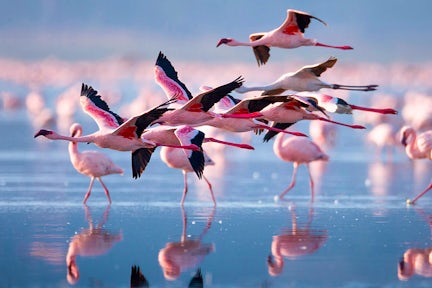
Wildlife at Lake Natron
Although the lake is deadly to most animals, a unique ecosystem has developed in this harsh environment, creating fascinating opportunities for nature enthusiasts and bird watchers.
Salt marshes and freshwater wetlands have formed, creating a habitat for the long-legged waterfowl. The lake also contains two endemic fish species: Alcolapia latilabris and Alcolapia ndalalani. You can also find Alcolapia alcalica at Lake Natron, but the species is not endemic.
Lesser flamingos are Lake Natron’s most famous attraction. 75% of the world’s population of lesser flamingos were born at this lake. They amass at the lake between August and October to lay their eggs, and the eggs hatch during the wet season in November.
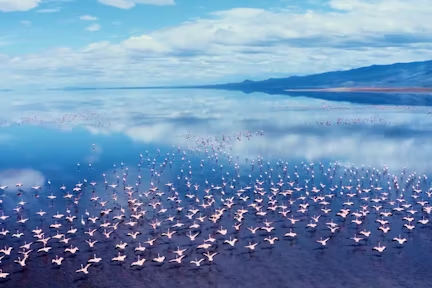
The surrounding area is also home to other species that can survive in this dry and dusty landscape, including kudus, oryxs, gerenuks, zebras, and ostriches. Fortunate adventurers may even catch a glimpse of a golden jackal!
Although Lake Natron does not contain the same array of wildlife as the surrounding natural parks, it is fascinating to see life so close to such a deadly body of water.
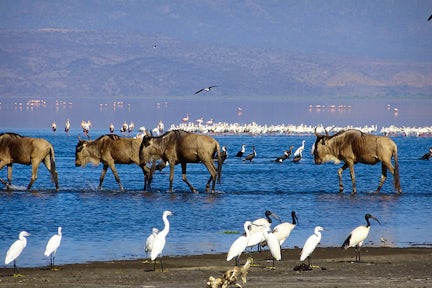
How to get to Lake Natron?
We recommend that you visit Lake Natron on your return from the Ngorongoro Conservation Area or the Serengeti National Park.
The road journey from the Serengeti is long, so you should break up the journey by spending a night at Kleins Gate, an exit point on the edge of Serengeti National Park.
The following morning, you will complete an 8-hour drive to Engaresero. Your accommodation in Engaresero will be your base for your adventures at Lake Natron.
After visiting Lake Natron, you should undertake a 3-hour road journey to Arusha.
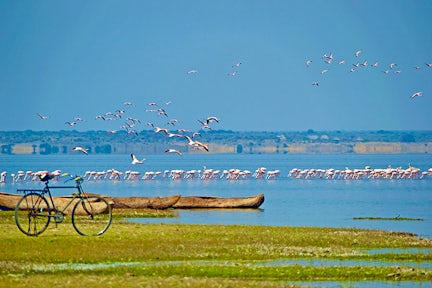
When is the best time to visit Lake Natron?
The best time to visit Lake Natron is during the dry season from late May to early November since these months are slightly cooler. The area is too hot during the short dry season from December to February.
In August, the flamingos start to gather at the lake and continue to amass until October. Visiting during these months gives you a chance of seeing this spectacular gathering.
The dry season also provides better conditions for hikes in the surrounding area since paths can be treacherous during the wet season.
During the dry season, there is a higher level of evaporation and this increases the salinity of the lake. The increase in the salinity of the lake causes cyanobacteria to multiply at a faster rate, and this gives the lake a richer shade of pink. The cyanobacteria provide food for the flamingos.
Photo credit: Lake Natron Camp

Activities at Lake Natron
Birdwatching
Naturally, Lake Natron is a hotspot for birdwatchers.
Lake Natron is the only regular breeding area in East Africa for 2.5 million lesser flamingos. Their dependence on the location led the International Union for Conservation of Nature to give the flamingos a status of ‘near threatened’.
Birdwatchers should take enough water and wear good shoes, as the ground can get very hot in this dry area of Tanzania.
Photo credit: Lake Natron Camp
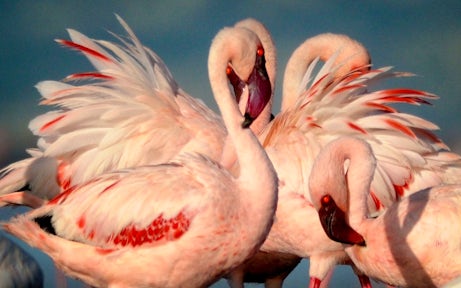
Hiking
For adventurers who like to challenge themselves, you can climb Ol Doinyo Lengai with the help of an experienced guide.
Ol Doinyo Lengai means ‘Mountain of God’ in the Maasai language. The climb is very steep, and we recommend that you have experience in mountaineering.
The climb is usually completed during the night to avoid the scorching temperatures of the daytime.
Climbing at night also allows you to watch the spectacular sunrise from the summit.
Photo credit: Lake Natron Camp
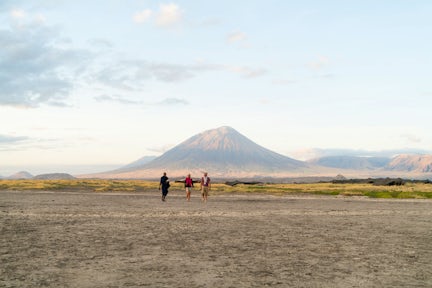
Other activities
There are several stunning waterfalls around the lake which you can visit.
You can also explore the local culture by visiting Maasai villages and their ‘boma’ (homesteads).
You can even spend an evening with the Maasai and learn about their customs as a warrior tribe, eat traditional food, and sleep under sky in the protection of their ‘boma’.
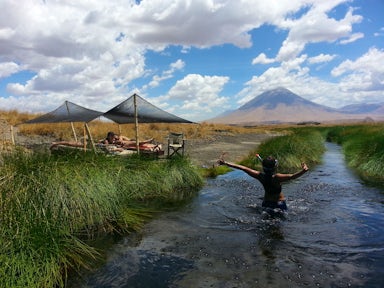
Where to stay at Lake Natron?
Other than the exciting opportunity to stay at a Maasai Boma, there are limited accommodation options around Lake Natron. Two options include the Lake Natron Camp and the Africa Safari Lake Natron:
The Lake Natron Camp- a basic but comfortable option. The tents are spacious, and they have their own porch area where you can watch the sunset. As there are only 10 tents, you are guaranteed a quiet and secluded stay. They also have a natural swimming pool where you can cool off at the end of the day.
The Africa Safari Lake Natron- a luxury lodge which is located on the border of the national park. It offers a variety of comfortable rooms at varying prices and it has its own pool and a bar area where you can enjoy your favourite evening tipple.
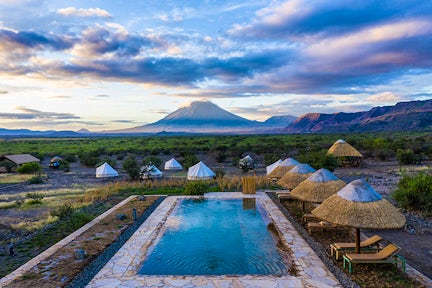
Lake Natron FQAs
-
Is it safe to swim in Lake Natron for humans?
No, humans should not enter the war as the high salt content would sting and burn on the skin and the water is extremely hot.
-
Do animals really calcify in the water?
The lake can be deadly for animals that land within the lake. Scientists assume that birds are confused by the reflecting nature of the lake and fly right into it. Even pilots have fallen prey to this illusion. The high salt content causes the dead animals to dry out and be preserved perfectly. However, Nick Brandt’s famous pictures of eerie animals calcified, perched on top of twigs and branches, are misleading as these are posed. He collected particularly well calcified animals from the shores of the Lake and photographed them as if they were alive in their natural habitats. Animals do not just calcify in the mere proximity of the lake, but need to be directly exposed to the water.
-
How can flamingos survive in Lake Natron?
Flamingos flourish in this water as there are no natural predators, thus making the breeding process less stressful. They actually feed on cyanobacteria, known as spirulina within the lake which gives the lake its pinkish colour. Spirulina thrive in alkaline water like that of Lake Natron. The combination of no predators and feeding source constitutes the perfect environment for flamingos to prosper, which is why up to 3 million Lesser Flamingos flock there every year.
-
Why is the Lake Natron pinkish-red in colour?
The lake is a mesmerising pinkish-red, especially in dry season, due to the microorganisms like spirulina that live within it and act as a feeding source for flamingos.
-
How expensive is Lake Natron?
Accomodation at Lake Natron is a lot more affordable than other parks in the area. Yet, it is a national park and thus Tanzanian park and conservation fees apply, costing around US$ 35 plus some additional fees that constantly change. We will take care of these entirely and include them within your booking.
Popular Trips to Tanzania
The tours below showcase just some of what is possible. Use these itineraries as starting points, or to draw inspiration. Then get in touch, and let our expert team help craft the perfect itinerary for you.
Ready to plan your African adventure?
Listen
We'll spend some time listening to your aspirations, then discuss the kind of experience that might suit you.
Match
Next we'll discuss the options, shortlist the best trips for you and present you our impartial recommendations.
Reserve
We'll place a 24 hour hold on your preferred option - without obligation - whilst we talk through the details.
Whatever your budget, group size, length of stay, preferred activity or appetite for adventure, we can help.



